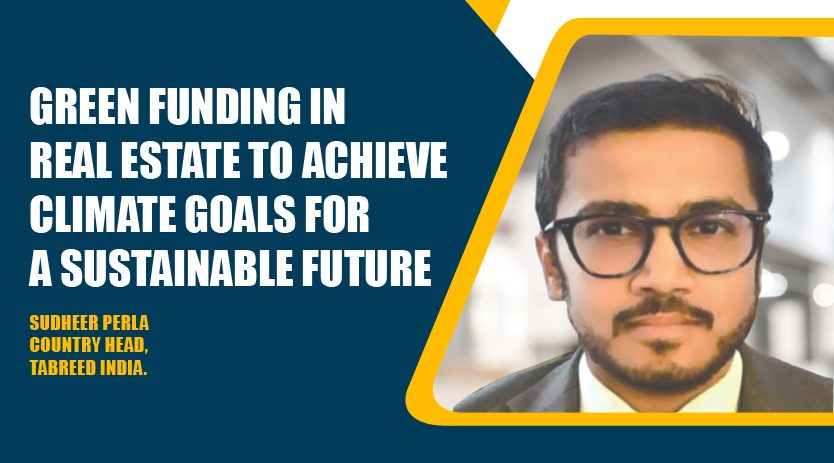The real estate sector has maximum potential for implementing environmental sustainability initiatives to meet climate change goals.
Among India’s fastest growing sectors, the real estate sector as a key growth driver has rapidly expanded beyond residential and commercial spaces to warehousing, data centres, and logistics. It has also emerged as an investment magnet, attracting a sizable percentage of the country’s FDI inflows. The sector is expected to contribute 13 percent of the country’s GDP by 2025, with market size of USD 1 trillion by 2030, up from USD 120 billion in 2017.
However, the real estate sector is a significant source of global greenhouse gas emissions and has one of the highest carbon footprints. It is critical for this sector to make climate conscious investments in energy efficiency and deploy new technology to help the economy decarbonise. This sector has a maximum need – and potential – for implementing environmental sustainability initiatives to meet climate change goals.
A recent World Economic Forum report reveals that the real estate sector consumes over 40 per cent of the global energy, and buildings originate 20 per cent of global greenhouse gas emissions, with a good percentage of it emanating from the building’s conventional cooling systems. Replacing these systems with sustainable cooling solutions like district cooling will be integral to achieving the Paris Agreement on Climate Change, which necessitates that the real estate sector has to reduce CO2 emissions by 36 per cent by 2030 to support staying within the 2°C thresholds. With India being among the global leaders in pursuing climate goals, a definitive focus by real estate developers on encouraging investments in sustainable technologies will significantly boost the country’s climate change goals and the Indian real estate stock globally. The role of investors in funding real estate projects is critical in scaling up the transition to a greener economy.

Green buildings with sustainable features
As the Indian real estate sector embarks on a new wave of expansion, governments, civic bodies and investors can play a crucial role in reducing greenhouse gases in the construction and real estate sector, both at the initial and operational stages. While governments and civic bodies can encourage the adoption of sustainable technologies like district cooling through comprehensive long-term policies, investors and developers can avail of the incentives to collaborate and implement such initiatives.
To preserve the environment for future generations, the real estate sector must undertake sustainability-oriented retrofits and renovate existing buildings. While repurposing existing buildings may be operationally and economically challenging in the short term, sustainability driven solutions like district cooling pay for themselves in the long term while attaining environmental targets that would otherwise be impossible. A green building with sustainable features conserves natural resources, cuts energy consumption, reduces harmful emissions and yields economic benefits throughout its lifetime, making green technologies both an environmental imperative and an economic one. Through eco-friendly technologies and with the help of energy-efficient systems, real estate can contribute significantly toward net-zero targets.
The Sustainability Dividend
While outdated properties will be compelled to offer a ‘grey discount’ for lack of sustainability, green buildings will command a premium in demand and yields, delivering a special sustainability dividend. For investors, this would translate into green buildings being better performing assets with a competitive advantage over the long term . The future of real estate should involve a holistic integration of sustainability into every aspect, from pre-design and funding to construction and management. Developers must show a genuine commitment to source “green” funding, which will be utilised reliably to achieve carbon reduction targets in new projects and reduce energy usage across the property portfolios. The role of financial investors in providing a committed source of capital will be crucial for real estate players as they transition from being the largest emitters of GHGs to developing green, carbon net zero buildings. For a tropical country like India, cooling is one area with massive potential for sustainability-driven synergies and savings besides using energy efficient materials and technologies.
Cooling Quotient
Cooling as a service market is at a relatively embryonic stage in India. Real estate developers mainly make their own varying cooling technology choices, funding the CAPEX from their balance sheets. Developers are not only allocating significant CAPEX spending on new building HVAC systems but also allocating huge sums on adapting existing buildings to make them more energy efficient. With HVAC energy consumption alone accounting for more than 40% of a commercial building’s total energy use, real estate developers – and investors – are looking to optimise the efficiency of this system.
The need of the hour is to move on from the currently prevailing energy-inefficient cooling systems – or even worse, individual air-conditioning units – to the new-age and sustainable district cooling system. District cooling and heating utilities provide more cost-effective, low-carbon pathways for large-scale projects and entire cities to meet their energy needs while accelerating the transition to green buildings and net zero carbon buildings. Sustainable cooling will be crucial in materialising a successful clean energy transition in the real estate sector. Focusing investments in these sustainable technologies will yield rich ecological and economic dividends for all the stakeholders
Cookie Consent
We use cookies to personalize your experience. By continuing to visit this website you agree to our Terms & Conditions, Privacy Policy and Cookie Policy.















